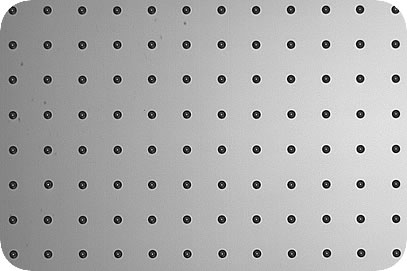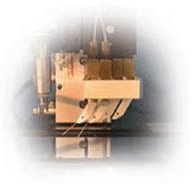 2852 Alton Pkwy, Irvine, CA 92606
2852 Alton Pkwy, Irvine, CA 92606
Non Contact Dispensing
AirJet Quanti:
This configuration uses an aerosol type of dispense nozzle that using pressurized air to atomize the fluid passing through the nozzle. This creates a quantitative spray format where a dot or line can be quantitatively generation on a continuous basis. AirJet technology is non-contact, quantitative aerosol dispensing. BioDot's proprietary technology couples any one of the three AirJets with a high resolution syringe pump to meter exact amounts of reagents. This process produces a precise and easy to use method for dispensing microliter quantities of fluids. Unique design features ensure repeatability and allow for disassembly and cleaning without affecting calibration.
BioJet Quanti HR:
This configuration uses a solenoid nozzle that is synchronized with a positive displacement of the syringe to dispense drops at frequencies in the range of 20-1000 Hz to dispense non-contact drops on a continuous base. This quantitative non contact technology couples the BioDot "drop-on-demand" valve with a high resolution syringe pump to meter precise amounts of reagent. Incorporating the benefits of non-contact dispensing and the ability to program exact drop volumes, results in BioJet technology being a flexible and highly accurate technology.
Feature |
Result |
| Resolution (microsteps) | 192,000 |
| Drive Mechanism | Ball Screw |
| Minimum Volume | 5.2 nL |
| Maximum Volume (Single Drop) | 4.0 µL |
| Maximum Volume (Multidrop Drop) | 12.5 mL |
| Accuracy (+/- % of target) |
5 |
| Precision | 10 |
| Theoretical Minimum Drop Size in µm (hemisphere) | 271 µm |
| Minimum Line Width (mm) | 0.3 mm |
| Maximum Line Width (mm) | 2.5 mm |
BioJet Plus:
The proprietary BioJet Plus technology was developed for high speed dispensing. The technology involves (1) the coupling of a high speed micro solenoid valve with a high resolution syringe pump and (2) synchronization of the dispense system with the movements of the stage. The result is an extremely fast dispensing system which can deliver volumes from 20 nL to 4 µL in a single drop. BioJet Plus can work in either an Aspirate/Dispense or Bulk Dispense modes.
Use BioJet Plus to dispense buffers, antibodies, enzymes or cells. BioJet Plus dispensing is independent of the substrate allowing flexible dispensing to microtiter plates, glass slides or membranes. BioJet Plus systems are available from compact R&D systems to complete integrated manufacturing modules.
Feature |
Result |
| Resolution (microsteps) | 192,000 |
| Drive Mechanism | Gear & Belt |
| Minimum Volume | 20.0 nL |
| Maximum Volume (Single Drop) | 4.0 µL |
| Maximum Volume (Multidrop Drop) | 1.0 mL |
| Accuracy (+/- % of target) |
5 |
| Precision | 10 |
| Theoretical Minimum Drop Size in µm (hemisphere) | 424 µm |
| Minimum Line Width (mm) | 0.5 mm |
| Maximum Line Width (mm) | 2.5 mm |
BioJet Ultra:
The BioJet Ultra piezo system is a non contact, liquid handling and spotting system. The technology dispenses with a high dynamic volume range (picoliter to microliter) and can accurately aspirate and dispense aqueous and organic solutions as well as living cells. Using piezo, spot volume can be changed as well as dispensing reagents on top of each other without contamination. Results can be analyzed with standard technology and give immediate results for optimal reaction parameters.
Feature |
Result |
Resolution (microsteps) |
N/A |
Drive Mechanism |
N/A |
Minimum Volume |
0.10 nL |
Maximum Volume (Single Drop) |
0.05 nL |
Maximum Volume (Multidrop Drop) |
1.0 µL |
Accuracy (+/- % of target) |
5 |
Precision |
10 |
Theoretical Minimum Drop Size in µm (hemisphere) |
75 µm |
Minimum Line Width (mm) |
0.1 mm |
Maximum Line Width (mm) |
0.3 mm |

Tandem Pump Dispensing
A syringe pump operates by first filling the syringe using a fill line connected to a reagent reservoir and then it can switch the outlet connection on the syringe to a second line and reverse the direction of the syringe plunger and displace the fluid through the second line to dispense the reagent using a programmed displacement. The problem is that once the dispensed fluid equals the original fill volume of the syringe the syringe must be refilled by switching the syringe valve to the fill position. At this point the dispensing operation must cease to allow the syringe to refill and then switching back to the dispensing position. In dispensing operations where continuous dispensing such as dispensing on a continuous moving web a single syringe pump will not work. The solution to this problem is to use two syringe pumps for a single dispense operation where the syringes alternately fill and dispense to provide continuous flow for the dispensing operation. This configuration is denoted as a “Tandem Pump”. This allows the use of small high resolution syringes in the range of 250 μL to be used. With this configuration continuous dispensing can be achieved with no limitations of the web length.
BioDot uses the “Tandem Pump” configuration for bulk dispensing on web based systems for both drop as well as continuous lines. There are three configurations of dispensers that use the Tandem configuration, FrontLines, AirJet Quanti and the BioJet Quanti.
Contact Dispensing
FrontLine
This configuration has a flexible dispense tip that rides on the substrate surface with the dispensed fluid emerging from dragging tip. The fluid flow rate can be synchronized with motion to create a quantitative rate of flow per unit length of reagent on the substrate surface.FrontLine dispensing is ideal for printing lines on membranes and other substrates for BioChips. The technology couples a high resolution syringe pump with a microtube. During dispensing the micro-tube glides across the surface of the membrane or substrate to create a quantitative line. The width of the line can be adjusted by increasing or decreasing the programmed volume of the line.



